
- #RASPBERRY PI 2 NOOBS GEANY PERMISSION DENIED INSTALL#
- #RASPBERRY PI 2 NOOBS GEANY PERMISSION DENIED UPDATE#
- #RASPBERRY PI 2 NOOBS GEANY PERMISSION DENIED SOFTWARE#
- #RASPBERRY PI 2 NOOBS GEANY PERMISSION DENIED FREE#
- #RASPBERRY PI 2 NOOBS GEANY PERMISSION DENIED WINDOWS#
Once you have an empty micro SD card formatted correctly, you are ready to copy the Raspberry Pi OS on it.Ī word of caution: some SD cards work better than others with the Raspberry Pi. Once you open the respective program, follow the menus to delete the existing contents of the SD card and format it using FAT32. Regardless of the tool you use, be very careful to select the correct drive / partition where your SD card is! A mistake here could potentially wipe-out your computer’s hard-drive!
#RASPBERRY PI 2 NOOBS GEANY PERMISSION DENIED INSTALL#
On my old Ubunto laptop, I had to install the package with “apt-get” and run it as administrator.
#RASPBERRY PI 2 NOOBS GEANY PERMISSION DENIED FREE#
For Linux, the start-up guide recommends GParted, a free application for managing disk partitions using a graphical interface.
#RASPBERRY PI 2 NOOBS GEANY PERMISSION DENIED WINDOWS#
To do that you can use the SD Formatter program by SD Associates, available for Windows and for Mac. The Micro SD card for the Raspberry Pi 2 needs to be formatted using the FAT32 format. I will cover the WiFi configuration in a follow-up post.
#RASPBERRY PI 2 NOOBS GEANY PERMISSION DENIED UPDATE#
Internet connection via an Ethernet cable, or a WiFi adapter to update the software. One of my two WiFi adapters did not work with the Pi, so I recommend to use the Ethernet cable for the initial set-up. 5 Volt micro USB power supply that can provide at least 1.2 A, with a 2.5 A recommended if you plan to use all 4 USB ports of the Pi. Here is more info on the Raspberry Pi power requirements. After the initial set-up, you can configure remote access to your Raspberry Pi, from another computer and drop the peripherals and the extra monitor. Wireless ones will work most of the time, but if you run into problems, try the “old school” wired versions. A DVI display will work as well, if you have a HDMI to DVI cable/adapter. A HDMI display (computer monitor, or TV) and an HDMI cable. You also need a way to write to the card either by using the SD card slot in your laptop, or a USB SD/Micro SD Card Reader/Writer. An 8 gig (for some extra space, a 4 gig one should work too) Micro SD card. #RASPBERRY PI 2 NOOBS GEANY PERMISSION DENIED SOFTWARE#
A computer with internet access to download the required software for the Raspberry Pi. Things you will need to set-up your Raspberry Pi 2: I plan to use Raspbian exclusively on my new Raspberry Pi 2 and this posts assumes you will be too. The most popular OS for the Raspberry Pi currently is a version of Linux, called Raspbian, specifically optimized for its hardware. All hail the devs.Unlike the Arduino, the Raspberry Pi is not a micro-controller, but rather a small, bare-bones computer that needs an operating system in order to run. sudo python file_name.pyįorever indebted to stackoverflow and the dev community. Print("Group id of the file:", os.stat(base_path).st_gid) Print("\nOwner id of the file:", os.stat(base_path).st_uid) 
Os.chown(base_path, user, group) # change directory permissions Print("Present owner and group of the specified path") Group = os.stat(base_path).st_gid # for getting details of the current group owner of the dir User = os.stat(base_path).st_uid # for getting details of the current user owner of the dir The solution that worked out for me here when I was using python 3 os package for performing operations on a directory where I didn't have sufficient permissions and access to got resolved by running the python file with sudo (root) i.e.: sudo python python_file_name.pyĪny other utility that you might also plan on using to chmod or chown that directory would also only work when you run it with sudo. As in my case would be ( mnist = input_data.read_data_sets("C:/Python/Python35/Lib/site-packages/tensorflow/examples/tutorials/mnist/MNIST_data", one_hot=True) )
Lastly, if you are following the tutorials, your call function would be ( mnist = input_data.read_data_sets("MNIST_data/", one_hot=True) ) Ĭhange the "MNIST_data/" parameter to your folder location. Change the "\" to "/" as "\" is used for escape characters, to access the folder locations. ( C:\Python\Python35\Lib\site-packages\tensorflow\examples\tutorials\mnist\MNIST_data )) Copy the address of the folder (it probably will be. Directly copy paste the files into the folder. 
 Then make a folder names MNIST_data (or your choice in your working directory/ site packages folder in the tensorflow\examples folder). gz files of the MNIST data set from the link ( ) There is a conflict in the permissions of the temporary files and I myself couldn't work out a way to change the permissions, but was able to work around the problem. Probably you are facing problem when a download request is made by the maybe_download function call in base.py file.
Then make a folder names MNIST_data (or your choice in your working directory/ site packages folder in the tensorflow\examples folder). gz files of the MNIST data set from the link ( ) There is a conflict in the permissions of the temporary files and I myself couldn't work out a way to change the permissions, but was able to work around the problem. Probably you are facing problem when a download request is made by the maybe_download function call in base.py file.







 0 kommentar(er)
0 kommentar(er)
